Context-Based Multi-Agent Recommender System, Supported on IoT, for Guiding the Occupants of a Building in Case of a Fire
Abstract
1. Introduction
- Development of a recommender solution based on a multi-agent system capable of improving efficiency in evacuating buildings in the event of a fire based on contextual information obtained through the IoT. The building evacuation solution provides real-time information to the occupants, contributing to conditioning the behavior of the occupants, leading them to focus on tasks and movements that lead to their exit from the building;
- Development of a computational model for the dynamic graph representing the building, as well the development of models that, based on contextual factors, ensure the referred building graph is updated to reflect the environmental conditions of the building.
2. Related Work
2.1. Introducing Concepts
2.1.1. Multi-Agent Systems
2.1.2. Recommender Systems
- Content-based approaches—the recommended items are those with similar content to past user preferences. This approach generates recommendations based on the attributes that characterize the items;
- Collaborative filtering approaches—where the recommended items are the ones that users with similar preferences to the active user liked in the past. Recommendations are generated based on user ratings;
- Hybrid approaches—in which the recommended items result from a combination of techniques used in collaborative and content-based approaches.
- Knowledge-based approaches—recommendations are generated from inferences about users’ preferences and needs. In this approach, the system knows how a specific item satisfies a user’s particular need [20];
- Demographic-based approaches—in which the system generates its recommendations based on the user’s demographic profile. This approach does not require a history of user ratings, as with collaborative and content-based approaches. [20].
- Approaches based on utility functions. Referred to by Akhtar e Agarwal [20] in their literature review, these approaches generate their recommendations from a utility function, which calculates the utility of a given item for a user;
- Context-based or context-aware approaches. This approach generates recommendations that consider the user context.
2.1.3. Internet of Things
2.2. Multi-Agent-Based Recommender Systems
2.3. IoT Recommender Systems
2.4. Fire Building Evacuation
2.5. Summary
3. The Proposed Solution: A Multi-Agent System for Recommending Fire Evacuation Routes in Buildings, Based on Context and IoT
3.1. An Ontological Model as Support for the Recommender System
3.2. The Recommender System
3.2.1. Contextual Factors to Consider
3.2.2. The Recommender System Formulation
- G is a graph representing the entire walkable area of a building and consists of vertices (V) and edges (A), which are pairs of vertices. A weight, w, associated with each edge represents the distance between the adjacent vertices or the time it takes an occupant to move between two adjacent vertices; thus, G can be written in the form:G = (V;A,w)
- P represents the set of all paths in the graph G such that:P = {P0, P1, …, PN}
- Each path Pi is a sequence of vertices such that:Pi = {vi0, vi1, …, viN}
- vii and vii−1 are adjacent vertices;
- E represents a subset of P that contains all the evacuation routes that a building occupant must travel through to reach a safe place such that:where vei0 to vein−1 are vertices representing points inside the building, and veiN represents a safe place, be it inside (refuge zone) or outside of the building;Ei = {vei0, vei1, …, veiN}
- Wi represents the length of Pi (or the time it takes to walk the path), such that:where win is the weight of the edge of the two adjacent vertices vii and vii−1.
3.2.3. The Computational Representation of the Graph
- For MA(t), it must be considered that:ma(i,j) = 1, if vertices i,j are adjacent
ma(i,j) = 0, if vertices i,j are not adjacent - Concerning the values of MD(t), which is a function of MD0 and MFc(t), one must consider:where:md((i,j),t) = (md0(i,j) + mfc((i,j),t))
- md0(i,j) represents the values of MD0 such that:md0(i,j) = dij, if vertices i,j are adjacent
md0(i,j) = ∞, if vertices i,j are not adjacent - dij is the distance between the adjacent vertices i,j;
- mfc(i,j), with i and j being adjacent vertices, represents the values that MFc takes over time.
3.2.4. Contextual Factors Matrix Update Model: Congestion
3.2.5. Contextual Factors Matrix Update Model: Risk
3.2.6. Contextual Factors Matrix Update Model: Congestion and Risk
3.3. The Multi-Agent Recommender System
3.3.1. Multi-Agent Recommender System Architecture
3.3.2. The Multi-Agent System
4. Experiments and Results
4.1. The Test Platform
4.2. Evaluation Criteria
4.3. Experimental Scenarios
- Scenario 1—Two occupants are positioned side by side in Room 2;
- Scenario 2—Group of 30 occupants positioned in Rooms 2 to 4;
- Scenario 3—Group of 200 occupants randomly positioned.
- Situation A—All occupants are familiar with the congress area and head towards the exit according to their knowledge of the space, so they do not follow the emergency signs;
- Situation B—None of the occupants know the space and continue to exit the building following the emergency signs.
4.4. Results
4.4.1. Results for Scenario 1—Two Occupants Are Positioned Side by Side in Room 2
4.4.2. Results for Scenario 2—Group of 30 Occupants Positioned in Rooms 2 to 4
4.4.3. Results for Scenario 3—Group of 200 Occupants Randomly Positioned
5. Discussion
5.1. Scenarios without Fire Deflagration
5.2. Scenarios with Fire Deflagration
5.3. Limitations of the Study
- In the case of congestion, a hypothetical sensor was considered that detects the number of occupants in a given section;
- In the case of the risk factor, a hypothetical risk sensor was considered, capable of reflecting the effects of the fire (smoke, temperature, and toxic gases) that could cause constraints in the evacuation routes. This assumption relates to the fire progression model incorporated into the Web simulation platform. However, it is important to note that the simplification mentioned does not harm the intended objectives, which were to create constraints in the evacuation routes, simulating the change in context in the building.
- Although preliminary tests were conducted for smaller buildings, it was considered that to address the study’s objectives, the tests should be focused on a medium-sized building with a high density of people and typically used by people unfamiliar with the space;
- It was assumed that there was no contact between the occupants, each going his own way as if the others did not exist. For example, if an occupant turns back because they see a blocked route, the system does not warn nearby occupants;
- The simulations assumed that some occupants do not know anything about the building; however, with few exceptions, there is never a total lack of knowledge of the space; occupants generally register where they enter the building, so they tend to know at least that route of return.
6. Conclusions and Future Work
Author Contributions
Funding
Data Availability Statement
Conflicts of Interest
References
- Ribeiro, J.; Almeida, J.E.; Rossetti, R.J.F.; Coelho, A.; Coelho, A.L. Towards a serious games evacuation simulator. CoRR 2013, 2013, abs/1303.3. [Google Scholar]
- Cordeiro, E. Modelação do Comportamento Humano em Caso de Incêndio (Tese de Doutoramento). Ph.D Thesis, Universidade da Beira Interior, Covilhã, Portugal, 2022. [Google Scholar]
- Miranda, J.; Mäkitalo, N.; Garcia-Alonso, J.; Berrocal, J.; Mikkonen, T.; Canal, C.; Murillo, J.M. From the Internet of Things to the Internet of People. IEEE Internet Comput. 2015, 19, 40–47. [Google Scholar] [CrossRef]
- Dorri, A.; Kanhere, S.; Jurdak, R. Multi-Agent Systems: A survey. IEEE Access 2018, 6, 28573–28593. [Google Scholar] [CrossRef]
- Wooldridge, M. An Introduction to MultiAgent Systems-Second Edition by Michael Wooldridge, 2nd ed.; John Wiley & Sons: Hoboken, NJ, USA, 2009; ISBN 978-0470519462. [Google Scholar]
- Maes, P. The agent network architecture (ANA). ACM SIGART Bull. 1991, 2, 115–120. [Google Scholar] [CrossRef]
- Franklin, S.; Graesser, A. Is it an agent, or just a program?: A taxonomy for autonomous agents. In Intelligent Agents III. Agent Theories, Architectures, and Languages; Lecture Notes in Computer Science (Including Subseries Lecture Notes in Artificial Intelligence and Lecture Notes in Bioinformatics); Springer: Berlin/Heidelberg, Germany, 2015; Volume 1193, pp. 21–35. [Google Scholar] [CrossRef]
- Morais, A.J.; Oliveira, E.; Jorge, A.M. A multi-agent recommender system. In Distributed Computing and Artificial Intelligence; Advances in Intelligent and Soft Computing; AISC: Chicago, IL, USA, 2012; Volume 151, pp. 281–288. [Google Scholar] [CrossRef]
- Morais, A.J. A Multi-agent Approach for Web Adaptation. In 7th International Conference on Practical Applications of Agents and Multi-Agent Systems (PAAMS 2009); Springer: Berlin/Heidelberg, Germany, 2009; pp. 349–355. [Google Scholar]
- Neto, J.; Morais, A.J. Multi-agent web recommendations. Adv. Intell. Syst. Comput. 2014, 290, 235–242. [Google Scholar] [CrossRef]
- Lee, W.-P.; Liu, C.-H.; Lu, C.-C. Intelligent agent-based systems for personalized recommendations in Internet commerce. Expert Syst. Appl. 2002, 22, 275–284. [Google Scholar] [CrossRef]
- Salazar, O.M.; Ovalle, D.A.; Duque, N.D. Adaptive and Personalized Educational Ubiquitous Multi-Agent System Using Context-Awareness Services and Mobile Devices. In Learning and Collaboration Technologies; Springer: Cham, Switzerland, 2015; pp. 301–312. [Google Scholar]
- Rodríguez, P.; Duque, N.; Rodríguez, S. Integral Multi-agent Model Recommendation of Learning Objects, for Students and Teachers. In Management Intelligent Systems; Springer: Berlin/Heidelberg, Germany, 2013; pp. 127–134. [Google Scholar]
- Twardowski, B.; Ryzko, D. IoT and Context-Aware Mobile Recommendations Using Multi-agent Systems. In Proceedings of the 2015 IEEE/WIC/ACM International Conference on Web Intelligence and Intelligent Agent Technology (WI-IAT), Singapore, 6–9 December 2015; Volume 1, pp. 33–40. [Google Scholar] [CrossRef]
- Batet, M.; Moreno, A.; Sánchez, D.; Isern, D.; Valls, A. Turist@: Agent-based personalised recommendation of tourist activities. Expert Syst. Appl. 2012, 39, 7319–7329. [Google Scholar] [CrossRef]
- Ricci, F.; Rokach, L.; Shapira, B. Introduction to Recommender Systems Handbook. In Recommender Systems Handbook; Springer: Boston, MA, USA, 2011. [Google Scholar] [CrossRef]
- Wei, Y.A.N.Z.; Moreau, L.U.C.; Jennings, N.R. A Market-Based Approach to Recommender Systems. ACM Trans. Inf. Syst. 2005, 23, 227–266. [Google Scholar] [CrossRef]
- Balabanović, M.; Shoham, Y. Fab: Content-based, collaborative recommendation. Commun. ACM 1997, 40, 66–72. [Google Scholar] [CrossRef]
- Burke, R. Hybrid web recommender systems. In The Adaptive Web; Lecture Notes in Computer Science (Including Subseries Lecture Notes in Artificial Intelligence and Lecture Notes in Bioinformatics); Springer: Berlin/Heidelberg, Germany, 2007; Volume 4321, pp. 377–408. [Google Scholar] [CrossRef]
- Akhtar, N.; Agarwal, D. A Literature Review of Empirical Studies of Recommendation Systems. Int. J. Appl. Inf. Syst. 2015, 10, 6–14. [Google Scholar] [CrossRef]
- Jannach, D.; Zanker, M.; Felfernig, A.; Friedrich, G. Recommender systems: An introduction. In Recommender Systems Handbook; Springer: Boston, MA, USA, 2011; Volume 40. [Google Scholar] [CrossRef]
- Rahman, M.M. Contextual Recommender Systems Using a Multidimensional Approach. Int. J. Intell. Inf. Syst. 2013, 2, 55–63. [Google Scholar] [CrossRef][Green Version]
- Adomavicius, G.; Mobasher, B.; Ricci, F.; Tuzhilin, A. Context-aware recommender systems. AI Mag. 2011, 32, 67–80. [Google Scholar] [CrossRef]
- Altulyan, M.; Yao, L.; Wang, X.; Huang, C.; Kanhere, S.S.; Sheng, Q.Z. Recommender Systems for the Internet of Things: A Survey. arXiv 2020, arXiv:2007.06758. [Google Scholar] [CrossRef]
- Haruna, K.; Akmar Ismail, M.; Suhendroyono, S.; Damiasih, D.; Pierewan, A.C.; Chiroma, H.; Herawan, T. Context-Aware Recommender System: A Review of Recent Developmental Process and Future Research Direction. Appl. Sci. 2017, 7, 1211. [Google Scholar] [CrossRef]
- Bazire, M.; Brézillon, P. Understanding context before using it. In Modeling and Using Context; Lecture Notes in Computer Science (Including Subseries Lecture Notes in Artificial Intelligence and Lecture Notes in Bioinformatics); Springer: Berlin/Heidelberg, Germany, 2005; Volume 3554, pp. 29–40. [Google Scholar] [CrossRef]
- Ashton, K. That ‘Internet of Things’ Thing. RFID J. 2009, 22, 97–114. [Google Scholar]
- Atzori, L.; Iera, A.; Morabito, G. The Internet of Things: A survey. Comput. Netw. 2010, 54, 2787–2805. [Google Scholar] [CrossRef]
- Sri, T.S.; Prasad, J.R.; Vijayalakshmi, Y. A review on the state of art of Internet of Things. Int. J. Adv. Res. Comput. Commun. Eng. 2016, 5, 189–193. [Google Scholar] [CrossRef]
- Laghari, A.A.; Wu, K.; Laghari, R.A.; Ali, M.; Khan, A.A. A Review and State of Art of Internet of Things (IoT). Arch. Comput. Methods Eng. 2021, 29, 1395–1413. [Google Scholar] [CrossRef]
- Neto, J.; Morais, A.J.; Gonçalves, R.; Coelho, A.L. Multi-Agent-Based Recommender Systems: A Literature Review. In Proceedings of the Sixth International Congress on Information and Communication Technology; Springer: Singapore, 2022; Volume 235, pp. 543–555. [Google Scholar]
- Adomavicius, G.; Tuzhilin, A. Toward the Next Generation of Recommender Systems: A Survey of the State of the Art and Possible Extensions. IEEE Trans. Knowl. Data Eng. 2005, 17, 734–749. [Google Scholar] [CrossRef]
- Bobadilla, J.; Ortega, F.; Hernando, A.; Gutiérrez, A. Recommender systems survey. Knowl. Based Syst. 2013, 46, 109–132. [Google Scholar] [CrossRef]
- Lu, J.; Wu, D.; Mao, M.; Wang, W.; Zhang, G. Recommender system application developments: A survey. Decis. Support Syst. 2015, 74, 12–32. [Google Scholar] [CrossRef]
- Beel, J.; Gipp, B.; Langer, S.; Breitinger, C. Research-paper recommender systems: A literature survey. Int. J. Digit. Libr. 2016, 17, 305–338. [Google Scholar] [CrossRef]
- Klašnja-Milićević, A.; Ivanović, M.; Nanopoulos, A. Recommender systems in e-learning environments: A survey of the state-of-the-art and possible extensions. Artif. Intell. Rev. 2015, 44, 571–604. [Google Scholar] [CrossRef]
- Borràs, J.; Moreno, A.; Valls, A. Intelligent tourism recommender systems: A survey. Expert Syst. Appl. 2014, 41, 7370–7389. [Google Scholar] [CrossRef]
- Lops, P.; de Gemmis, M.; Semeraro, G. Content-based Recommender Systems: State of the Art and Trends. In Recommender Systems Handbook; Ricci, F., Rokach, L., Shapira, B., Kantor, P.B., Eds.; Springer: Boston, MA, USA, 2011; pp. 73–105. [Google Scholar] [CrossRef]
- Yang, X.; Guo, Y.; Liu, Y.; Steck, H. A survey of collaborative filtering based social recommender systems. Comput. Commun. 2014, 41, 1–10. [Google Scholar] [CrossRef]
- Burke, R. Hybrid Recommender Systems: Survey and Experiments. User Model. User-Adapt. Interact. 2022, 12, 331–370. [Google Scholar] [CrossRef]
- Verbert, K.; Manouselis, N.; Ochoa, X.; Wolpers, M.; Drachsler, H.; Bosnic, I.; Duval, E. Context-Aware Recommender Systems for Learning: A Survey and Future Challenges. IEEE Trans. Learn. Technol. 2012, 5, 318–335. [Google Scholar] [CrossRef]
- Yao, L.; Sheng, Q.Z.; Ngu, A.H.H.; Ashman, H.; Li, X. Exploring recommendations in internet of things. In Proceedings of the 37th International ACM SIGIR Conference on Research & Development in Information Retrieval—SIGIR ’14, Virtual Event, China, 6–11 July 2014; pp. 855–858. [Google Scholar] [CrossRef]
- Forestiero, A. Multi-Agent Recommendation System in Internet of Things. In Proceedings of the 17th IEEE/ACM International Symposium on Cluster, Cloud and Grid Computing (CCGRID), Madrid, Spain, 14–17 May 2017; pp. 772–775. [Google Scholar] [CrossRef]
- Salman, Y.; Abu-Issa, A.; Tumar, I.; Hassouneh, Y. A Proactive Multi-type Context-Aware Recommender System in the Environment of Internet of Things. In Proceedings of the 2015 IEEE International Conference on Computer and Information Technology, Ubiquitous Computing and Communications, Dependable, Autonomic and Secure Computing, Pervasive Intelligence and Computing, Liverpool, UK, 26–28 October 2015; pp. 351–355. [Google Scholar] [CrossRef]
- Tu, M.; Chang, Y.-K.; Chen, Y.-T. A Context-Aware Recommender System Framework for IoT Based Interactive Digital Signage in Urban Space. In Proceedings of the Second International Conference on IoT in Urban Space, Tokyo, Japan, 24–25 May 2016; pp. 39–42. [Google Scholar] [CrossRef]
- Di Martino, S.; Rossi, S. An Architecture for a Mobility Recommender System in Smart Cities. Procedia Comput. Sci. 2016, 98, 425–430. [Google Scholar] [CrossRef]
- Cha, S.; Ruiz, M.P.; Wachowicz, M.; Tran, L.H.; Cao, H.; Maduako, I. The role of an IoT platform in the design of real-time recommender systems. In Proceedings of the 2016 IEEE 3rd World Forum on Internet of Things, WF-IoT 2016, Reston, VA, USA, 12–14 December 2017; pp. 448–453. [Google Scholar] [CrossRef]
- Forouzandeh, S.; Aghdam, A.R.; Barkhordari, M.; Fahimi, S.A.; Vayqan, M.K.; Forouzandeh, S.; Khani, E.G. Recommender system for Users of Internet of Things (IOT). IJCSNS Int. J. Comput. Sci. Netw. Secur. 2017, 17, 46–51. [Google Scholar]
- Bi, H.; Gelenbe, E. A Survey of Algorithms and Systems for Evacuating People in Confined Spaces. Electronics 2019, 8, 711. [Google Scholar] [CrossRef]
- Wang, J.; Zhao, H.; Winter, S. Integrating sensing, routing and timing for indoor evacuation. Fire Saf. J. 2015, 78, 111–121. [Google Scholar] [CrossRef]
- Liu, J.; Rojas-Cessa, R.; Dong, Z. Sensing, calculating, and disseminating evacuating routes during an indoor fire using a sensor and diffusion network. In Proceedings of the 2016 IEEE 13th International Conference on Networking Sensing, and Control (ICNSC), Mexico City, Mexico, 28–30 April 2016; pp. 1–6. [Google Scholar] [CrossRef]
- Hart, P.E.; Nilsson, N.J.; Raphael, B. A Formal Basis for the Heuristic Determination of Minimum Cost Paths. IEEE Trans. Syst. Sci. Cybern. 1968, 4, 100–107. [Google Scholar] [CrossRef]
- Lujak, M.; Giordani, S.; Ossowski, S. An architecture for safe evacuation route recommendation in smart spaces. In Proceedings of the Ninth International Workshop on Agents in Traffic and Transportation (ATT 2016), New York, NY, USA, 10 July 2016; Available online: http://ceur-ws.org/Vol-1678/ (accessed on 21 October 2022).
- Shikhalev, D.; Khabibulin, R.; Kemloh, U.; Gudin, S. Evacuation Simulation under Different Conditions using a Safest Path Routing Algorithm. In Proceedings of the 18th International Conference on Enterprise Information Systems, Rome, Italy, 25–28 April 2016; pp. 62–69. [Google Scholar] [CrossRef]
- Cormen, T.H.; Leiserson, C.E.; Rivest, R.L. THe Floyd-Warshall Algorithm. In Introduction to Algorithms, 1st ed.; MIT Press and McGraw-Hill: Cambridge, MA, USA, 1990; pp. 558–565. [Google Scholar]
- Lujak, M.; Ossowski, S. Evacuation route optimization architecture considering human factor. AI Commun. 2017, 30, 53–66. [Google Scholar]
- Gokceli, S.; Zhmurov, N.; Kurt, G.K.; Ors, B. IoT in Action: Design and Implementation of a Building Evacuation Service. J. Comput. Netw. Commun. 2017, 2017, 8595404. [Google Scholar] [CrossRef]
- Lee, D.; Kim, D.; Lee, J.; Lee, S.; Hwang, H.; Mariappan, V.; Lee, M.; Cha, J. Environment Adaptive Emergency Evacuation Route GUIDE through Digital Signage Systems. Int. J. Adv. Cult. Technol. 2017, 5, 90–97. [Google Scholar] [CrossRef][Green Version]
- Li, J.J.; Zhu, H.Y. A Risk-based Model of Evacuation Route Optimization under Fire. Procedia Eng. 2018, 211, 365–371. [Google Scholar] [CrossRef]
- Neto, J.; Morais, A.J.; Gonçalves, R.; Coelho, A.L. An Ontology for Fire Building Evacuation. In Lecture Notes in Networks and Systems, Proceedings of the Sixth International Congress on Information and Communication Technology, London, Uk, 25–26 February 2021; Springer: Singapore, 2022; Volume 216, pp. 975–985. [Google Scholar] [CrossRef]
- Neto, J.; Morais, A.J.; Gonçalves, R.; Coelho, A.L. An Ontological Model for Fire Evacuation Route Recommendation in Buildings. In Lecture Notes in Networks and Systems, Proceedings of the Seventh International Congress on Information and Communication Technology: ICICT 2022, London, UK, 21–24 February 2022; Springer: Singapore, 2022; Volume 464, pp. 109–119. [Google Scholar] [CrossRef]
- Neto, J.; Morais, A.J.; Gonçalves, R.; Coelho, A.L. Geometric and Physical Building Representation and Occupant’s Movement Models for Fire Building Evacuation Simulation. In Proceedings of the Seventh International Congress on Information and Communication Technology. Lecture Notes in Networks and Systems; Yan, X.-S., Sherratt, S., Dey, N., Joshi, A., Eds.; Springer: London, UK, 2022; Volume 448, pp. 761–772. [Google Scholar] [CrossRef]
- Coelho, A.L. Modelação Matemática da Evacuação de Edifícios Sujeitos à Acção de um Incêndio. Tese de Doutoramento, Repositório Aberto da Universidade do Porto, FEUP-Faculdade de Engenharia, Porto, Portugal, 1997. Available online: https://hdl.handle.net/10216/12585 (accessed on 14 April 2022).
- PD 7974-6:2019; Application of Fire Safety Engineering Principles to the Design of Buildings Human Factors. Life Safety Strategies. Occupant Evacuation, Behaviour and Condition (Sub-System 6)-European Standards. British Standards Institution: Loughborough, UK, 2019.
- Coelho, A.L.; Neto, J. A importância da modelação das condições de segurança ao incêndio na reabilitação de edifício. In Livro de Atas do ENCORE 2020-4o Encontro de Conservação e Reabilitação de Edifícios; Laboratório Nacional de Engenharia Civil: Lisboa, Portugal, 2020; pp. 345–356. [Google Scholar] [CrossRef]
- Tisue, S.; Tisue, S.; Wilensky, U. Netlogo: A simple environment for modeling complexity. In Proceedings of the International Conference on Complex Systems, Boston, MA, USA, 16–21 May 2004; pp. 16–21. [Google Scholar]
- Taillandier, P.; Gaudou, B.; Grignard, A.; Huynh, Q.N.; Marilleau, N.; Caillou, P.; Philippon, D.; Drogoul, A. Building, composing and experimenting complex spatial models with the GAMA platform. GeoInformatica 2018, 23, 299–322. [Google Scholar] [CrossRef]
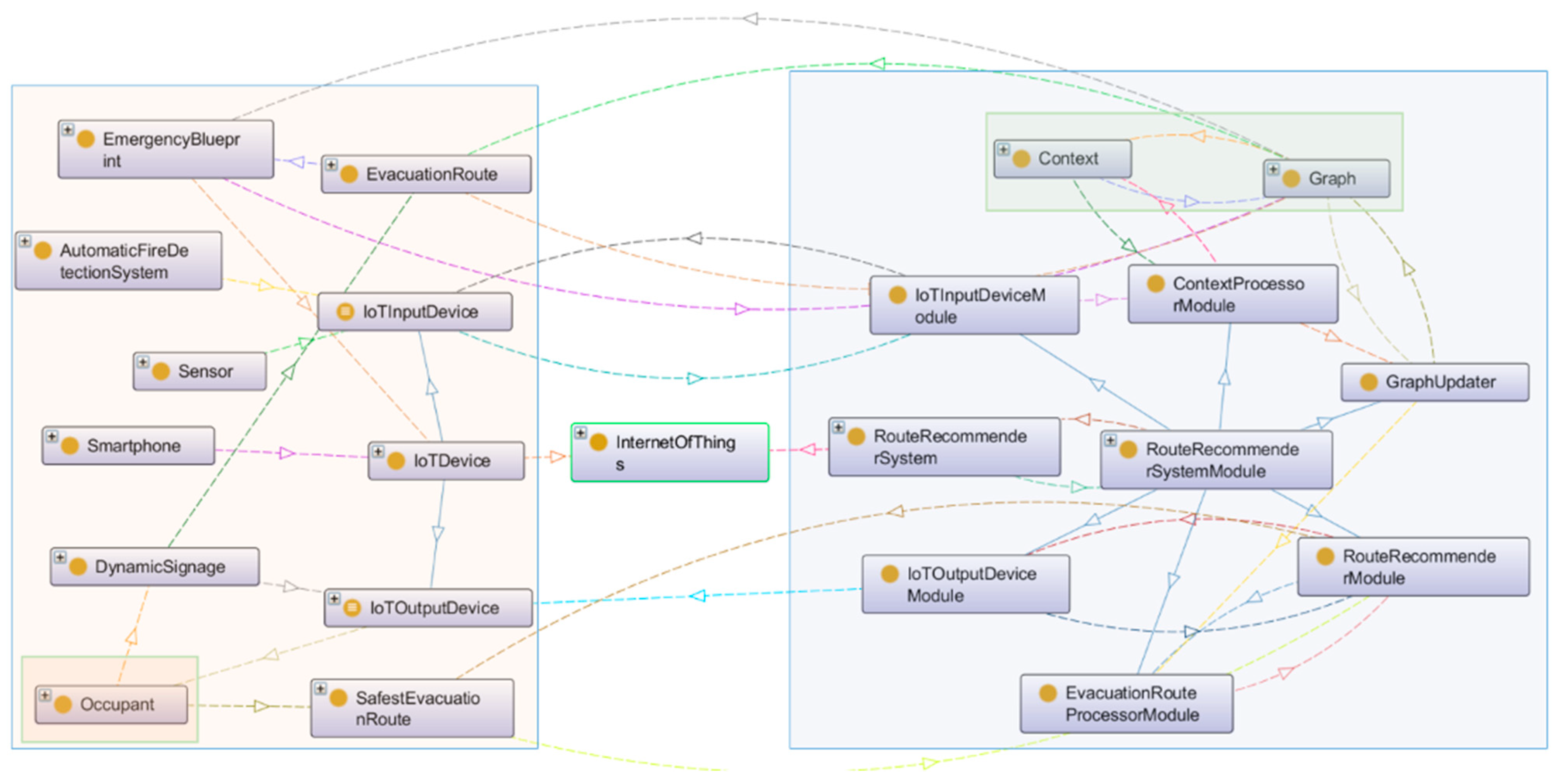

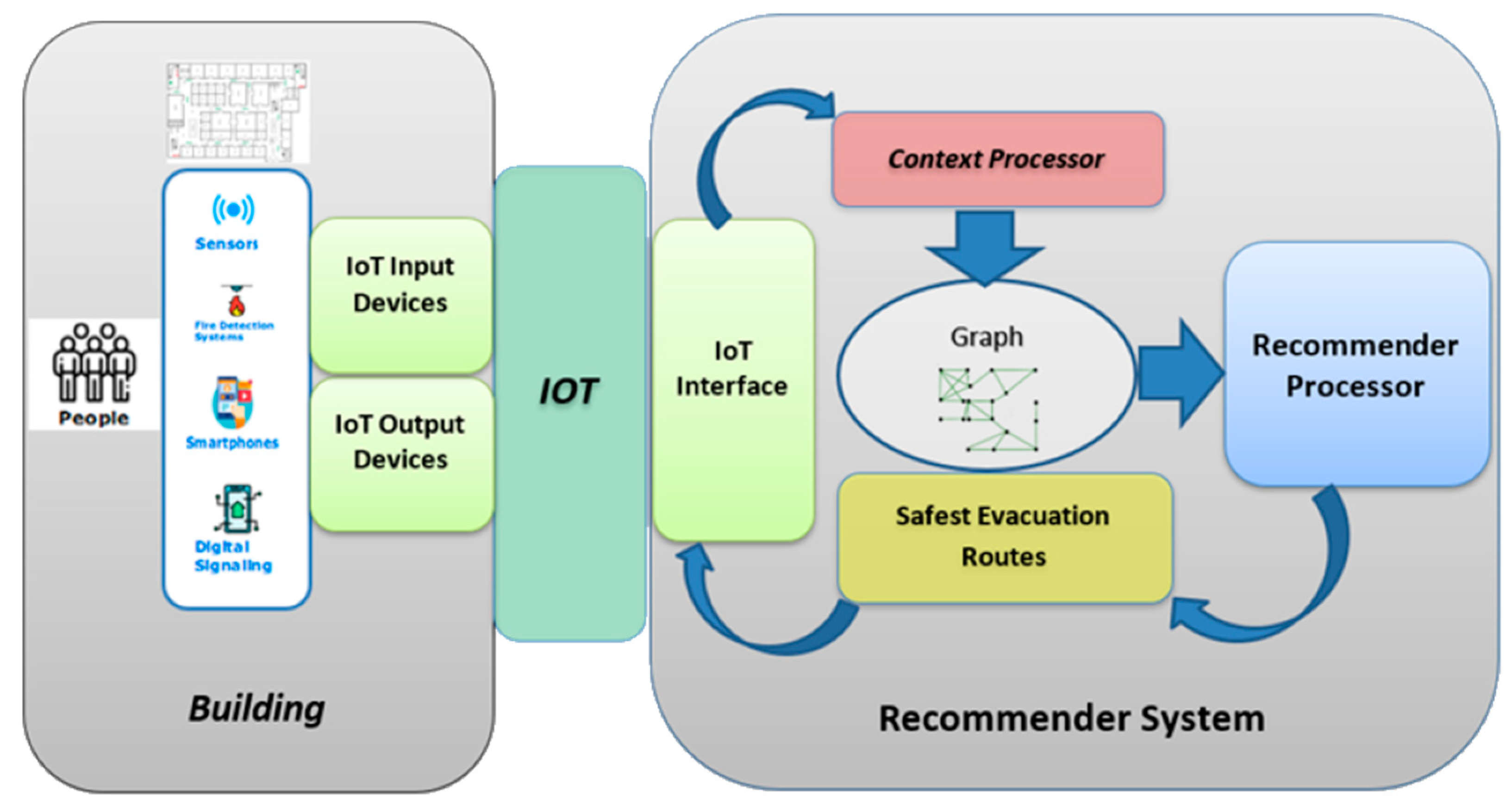
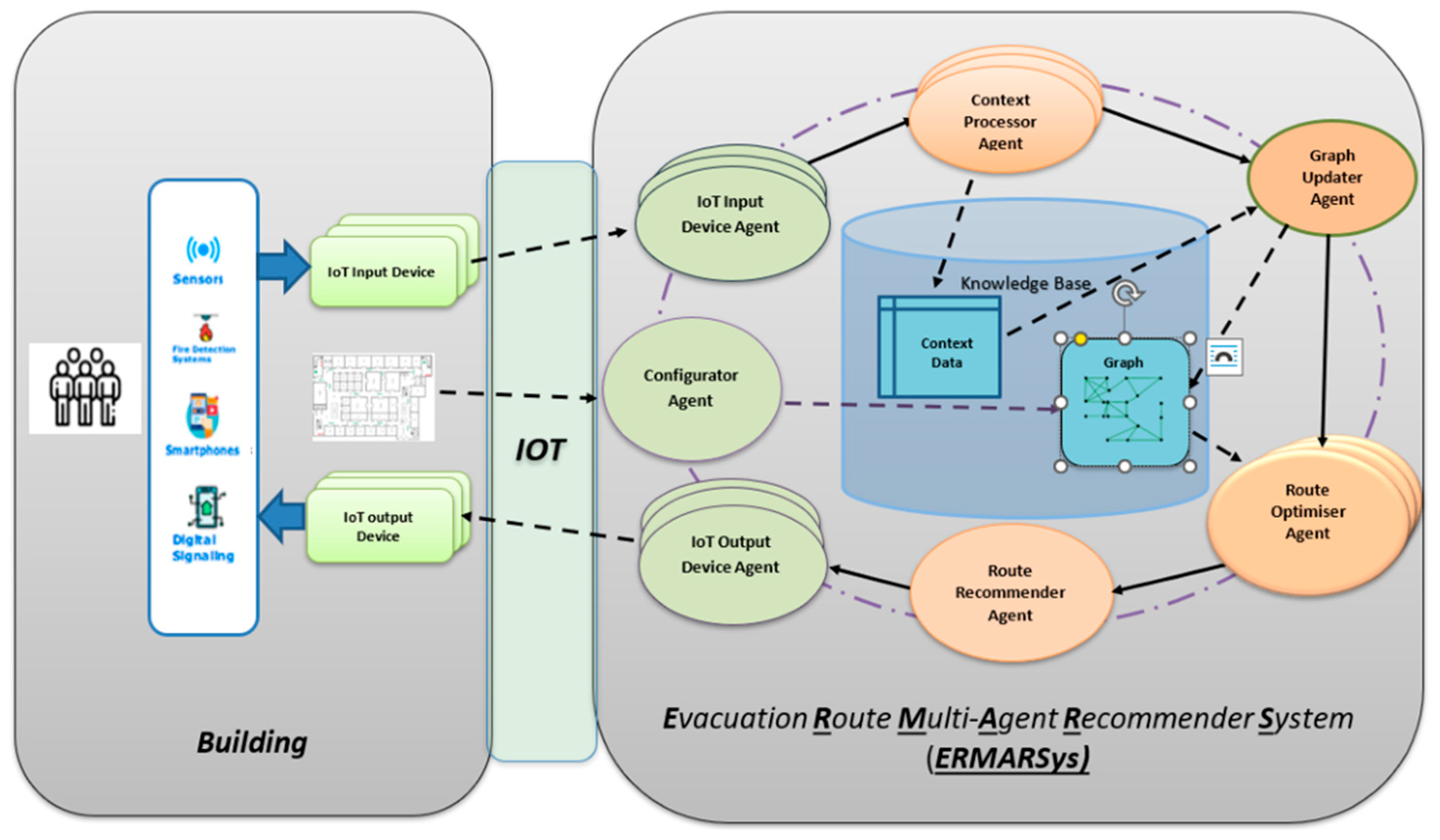






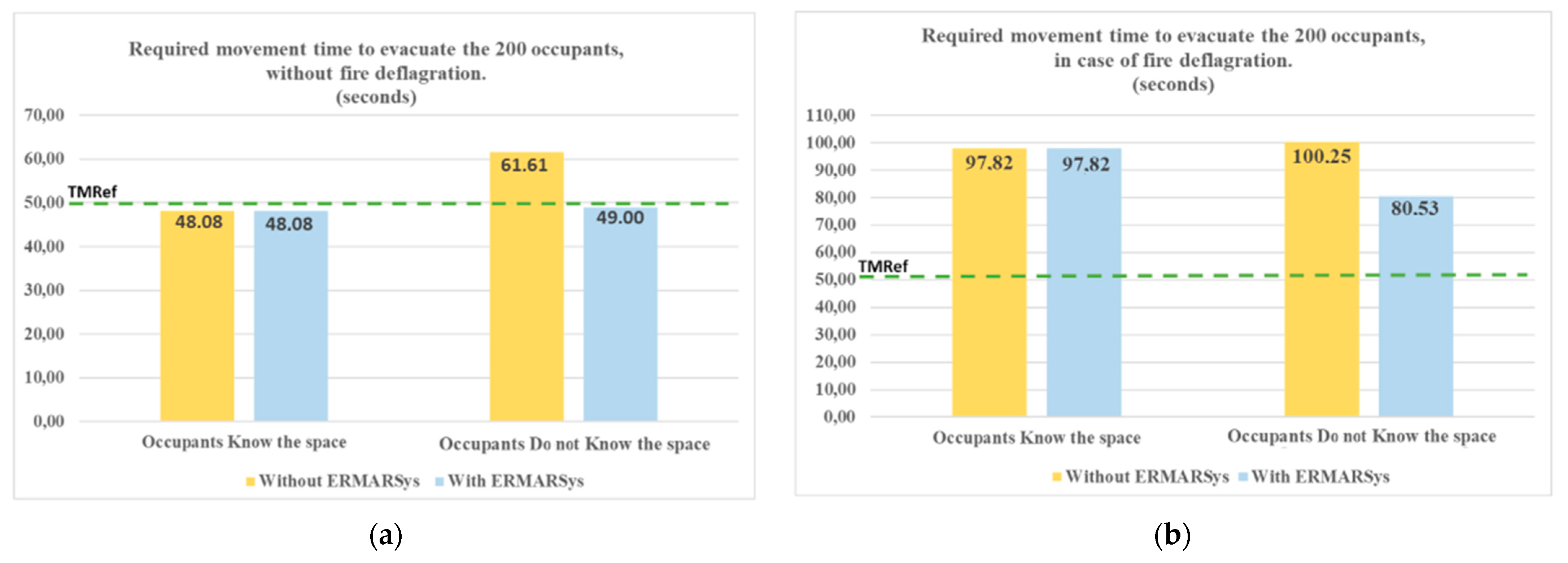
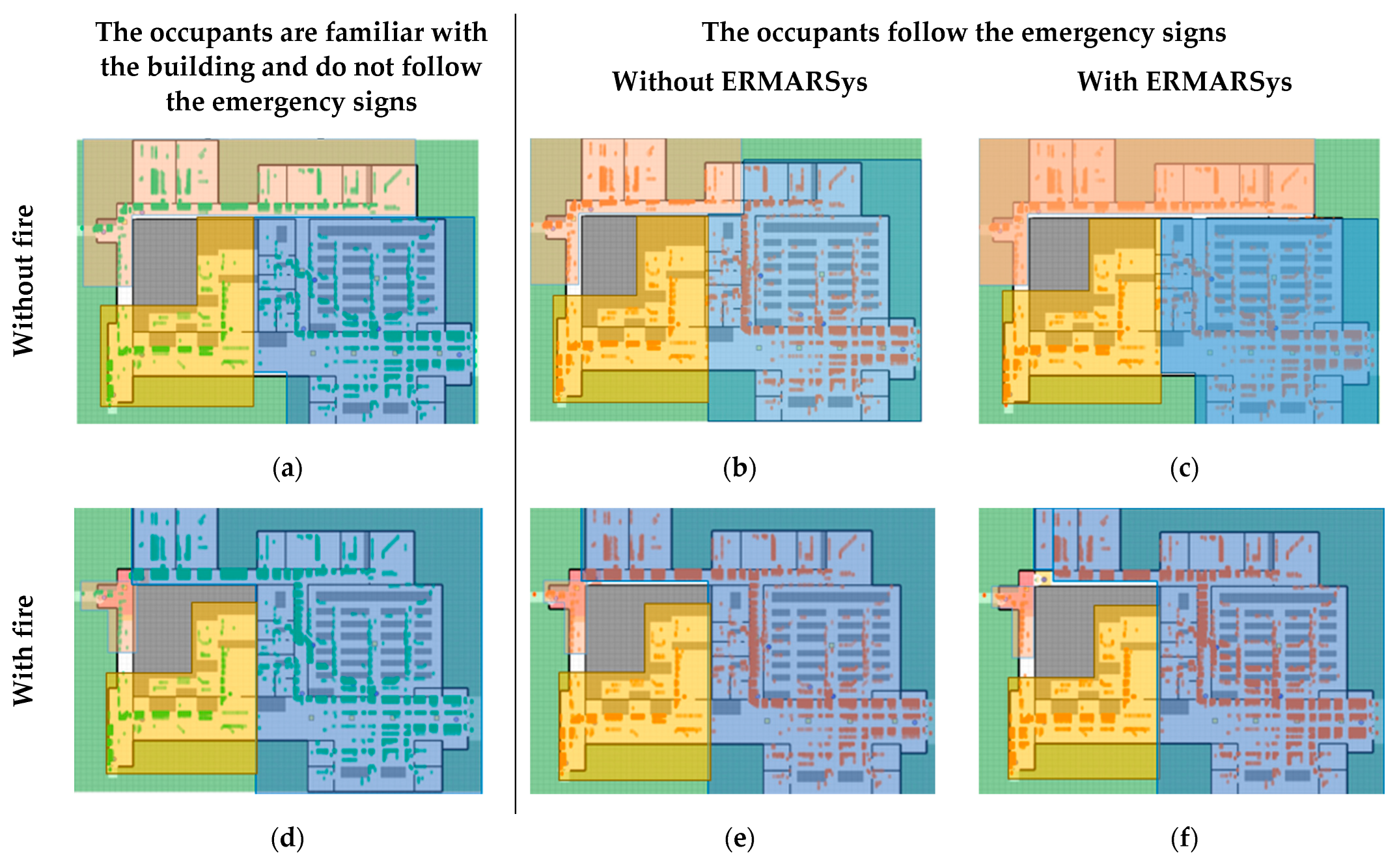
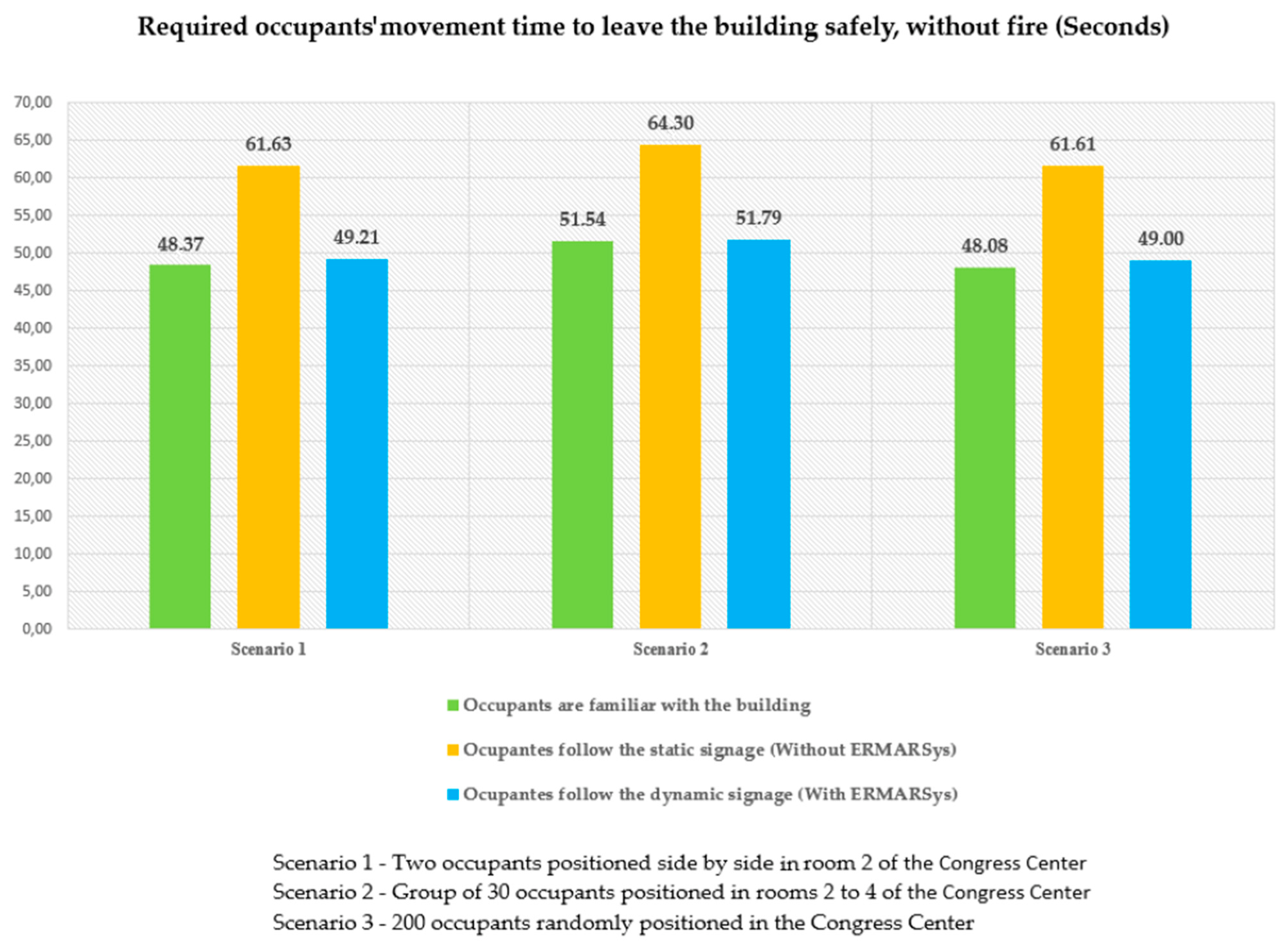
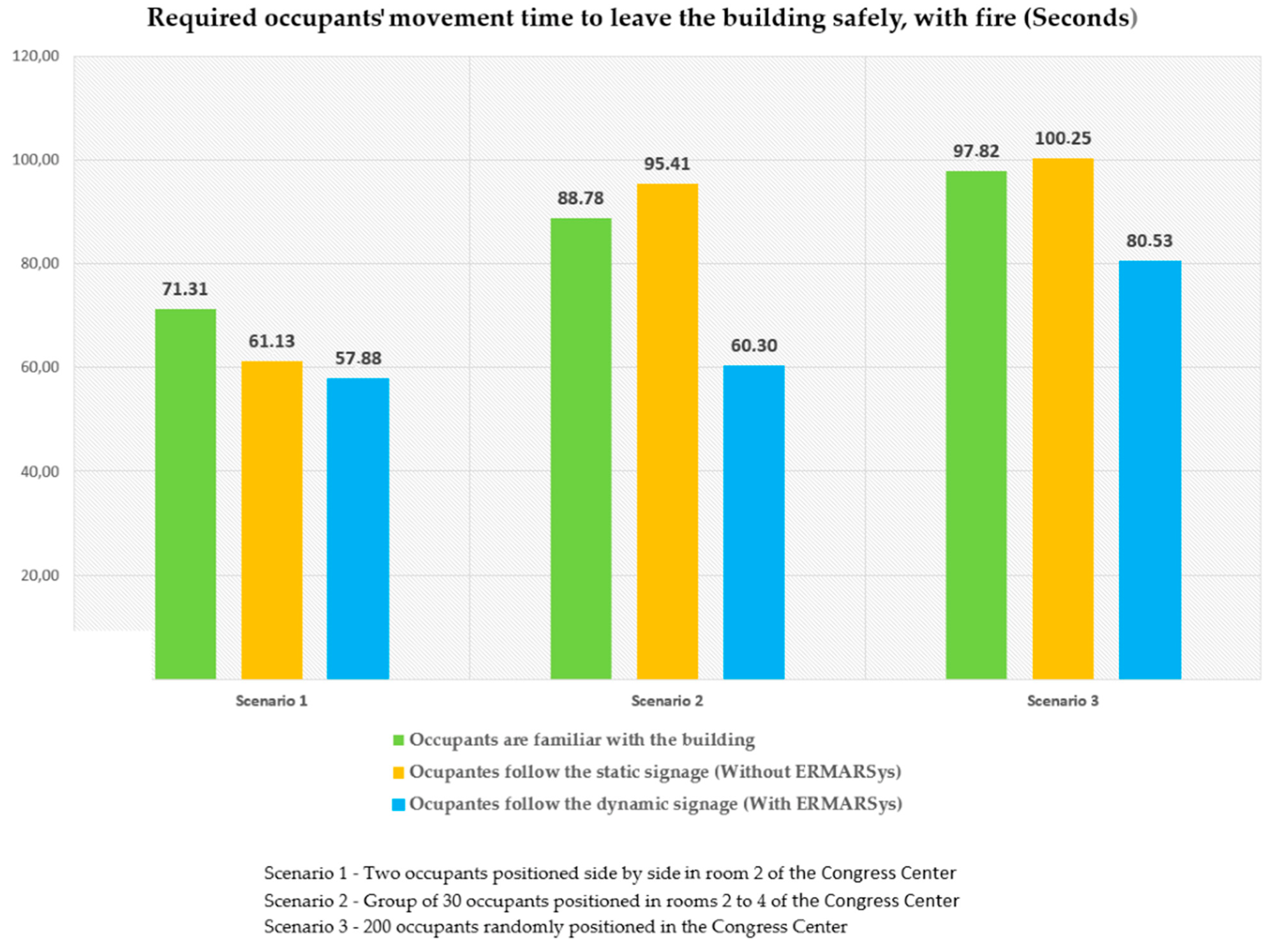
| How Contextual Factors Change with Time | Knowledge of the Recommender Systems about Contextual Factors | ||
|---|---|---|---|
| Fully Observable | Partially Observable | Unobservable | |
| Static | Everything Known about Context | Partial and Static Context Knowledge | Latent Knowledge of Context |
| Dynamic | Context Relevance Is Dynamic | Partial and Dynamic Context Knowledge | Nothing Is Known about Context |
| Smoke Density and Irritancy D.m−1 (Extinction Coefficient) | Approximate Visibility Diffuse Illumination | Reported Effects |
|---|---|---|
| None | Unaffected | Walking speed of 1.2 m/s |
| 0.5 (1.15) non-irritant | 2 m | Walking speed of 0.3 m/s |
| 0.2 (0.5) irritant | Reduced | Walking speed of 0.3 m/s |
| 0.33 (0.76) mixed | 3 m approx. | 30% of people turn back rather than enter the smoke area |
| Suggested tenability limits for buildings: | ||
| small enclosures and travel distances: D.m−1 = 0.2 (visibilities of 5 m) large enclosures and travel distances: D.m−1 = 0.08 (visibilities of 10 m) | ||
| Hazard Factor | Impact on Occupants’ Movement |
|---|---|
| Smoke and toxic and asphyxiating gases | If there is smoke with density D.m−1 ≤ 0.2, an occupant can move through it. However, the occupant’s speed will tend to reduce to 0.3 m/s, so more time is needed to cover that section of the route affected by the smoke. As the speed in smoke-free conditions is 1.2 m/s (Table 2), an occupant will take four times longer to travel that section. |
| If D.m−1 > 0.2, the model considers that there are no conditions allowing occupants to enter or travel through the area with smoke, especially as the probability of the existence of irritating or even asphyxiating gases is high, so the section must be considered prohibited. | |
| Heat | The evacuation routes are traversable where the temperature in the cold layer is below 60 °C. For higher values, the presence of people is possible, but with low saturations and only in situations where people are already in the affected area, so people should avoid entering a section with temperatures above 60 °C. |
| Risk Level | Effects on Occupants’ Movement | mfc((i,j),t) Values (Assumptions in the Developed Prototype) |
|---|---|---|
| 0 | The occupants move at normal speed. The graph is not affected. | mfc((i,j),t) not affected |
| 1 | It reflects the smoke in the area but with a reduced impact on the occupants’ movement. This level of risk reflects in the graph by increasing the length of the section. However, a person will continue his way through the smoke. | The model assumes a 20% decrease in the occupants’ speed, which is equivalent to an apparent 20% increase in the initial length of the route section, so:
mfc((i,j),t) = 0,2 * md0(i,j)
|
| 2 | Both risk levels reflect that smoke density and heat are already noticeable. Therefore, those in the area will continue on their way if the bearable limits are ensured. However, the recommender system must penalize the routes that use the section in question; this fact will be reflected in the building graph, as shown in the column on the right. | A 50% speed decrease is assumed, which means an apparent doubling of the initial length of the section, so that:
mfc ((i,j),t) = 1,0 * md0(i,j)
|
| 3 | The model assumes that the occupants’ speed decreases from 1.2 m/s to 0.3 m/s, which means an apparent quadrupling in the initial length of the section, so:
mfc ((i,j),t) = 3,0 * md0(i,j)
| |
| 4 | Refers to route sections in which factor values exceed the bearable limits for people. The recommender system must consider these sections prohibited, so the graph must be updated accordingly. | The interdiction of the section is reflected either in the adjacency matrix—nodes i and j are no longer adjacent—or in the matrix of hazard factors, reflected in the following equations:
ma((i,j),t) = 0
mfc((i,j),t) = ∞
|
| 5 |
| Risk Level | Graph Matrix Values | Value Updates due to Risk | Value Updates due to Congestion |
|---|---|---|---|
| 0 | Mfc values | mfc((i,j),t) does not change | mfc((i,j),t) = VNE * T((i,j),t) |
| MD and MA values | md((i,j),t) = md0 (i,j) + VNE * T((i,j),t) ma((i,j),t) does not change | ||
| 1 | Mfc values | mfc((i,j),t) = 0,2 * md0 (i,j) | mfc((i,j),t) = VNE * T((i,j),t) |
| MD and MA values | md((i,j),t) = md0 (i,j) + 0,2 * md0 (i,j) + VNE * T((i,j),t) ma((i,j),t) does not change | ||
| 2 | Mfc values | mfc((i,j),t) = 1,0 * md0 (i,j) | mfc((i,j),t) = VNE * T((i,j),t) |
| MD and MA values | md((i,j),t) = md0 (i,j) + 1,0 * md0 (i,j) + VNE * T((i,j),t) ma((i,j),t) does not change | ||
| 3 | Mfc values | mfc((i,j),t) = 3,0 * md0 (i,j) | mfc((i,j),t) = VNE * T((i,j),t) |
| MD and MA values | md((i,j),t) = md0 (i,j) + 3,0 * md0 (i,j) + VNE * T((i,j),t) ma((i,j),t) does not change | ||
| 4 and 5 | Mfc values | mfc((i,j),t) = ∞ | mfc((i,j),t) = VNE * T((i,j),t) |
| MD and MA values | mfc((i,j),t) = ∞ ma((i,j),t) = 0 | ||
| ERMARSys Impact | ||
|---|---|---|
| Impact on Movement Time | Impact on Evacuation Pattern | |
| The fire does not cause constraints or blockage of routes. | As seen from Figure 13, ERMARSys allows occupants who are unfamiliar with the building to leave the building as efficiently as those who are familiar with the building. When occupants follow ERMARSys recommendations, it takes about 20% less time for all occupants to be safe. | The images in Figure 8, Figure 10 and Figure 12 show that the evacuation pattern of those who follow EMARSys recommendations is similar to that of those who are familiar with the building. |
| The fire causes constraints or blockages of routes | As can be seen from Figure 14, ERMARSys allows occupants who are unfamiliar with the building to leave the building more efficiently than those who know the building or do not follow its recommendations. For example, in the case of the scenario with 200 occupants, it takes about 17.7% less time for all occupants to be safe. | The images in Figure 8, Figure 10 and Figure 12 show that when the occupants follow the recommendations of the ERMARSys system, they become aware of the fire constraints earlier, avoiding the need to reverse the direction of movement. |
Publisher’s Note: MDPI stays neutral with regard to jurisdictional claims in published maps and institutional affiliations. |
© 2022 by the authors. Licensee MDPI, Basel, Switzerland. This article is an open access article distributed under the terms and conditions of the Creative Commons Attribution (CC BY) license (https://creativecommons.org/licenses/by/4.0/).
Share and Cite
Neto, J.; Morais, A.J.; Gonçalves, R.; Coelho, A.L. Context-Based Multi-Agent Recommender System, Supported on IoT, for Guiding the Occupants of a Building in Case of a Fire. Electronics 2022, 11, 3466. https://doi.org/10.3390/electronics11213466
Neto J, Morais AJ, Gonçalves R, Coelho AL. Context-Based Multi-Agent Recommender System, Supported on IoT, for Guiding the Occupants of a Building in Case of a Fire. Electronics. 2022; 11(21):3466. https://doi.org/10.3390/electronics11213466
Chicago/Turabian StyleNeto, Joaquim, António Jorge Morais, Ramiro Gonçalves, and António Leça Coelho. 2022. "Context-Based Multi-Agent Recommender System, Supported on IoT, for Guiding the Occupants of a Building in Case of a Fire" Electronics 11, no. 21: 3466. https://doi.org/10.3390/electronics11213466
APA StyleNeto, J., Morais, A. J., Gonçalves, R., & Coelho, A. L. (2022). Context-Based Multi-Agent Recommender System, Supported on IoT, for Guiding the Occupants of a Building in Case of a Fire. Electronics, 11(21), 3466. https://doi.org/10.3390/electronics11213466









